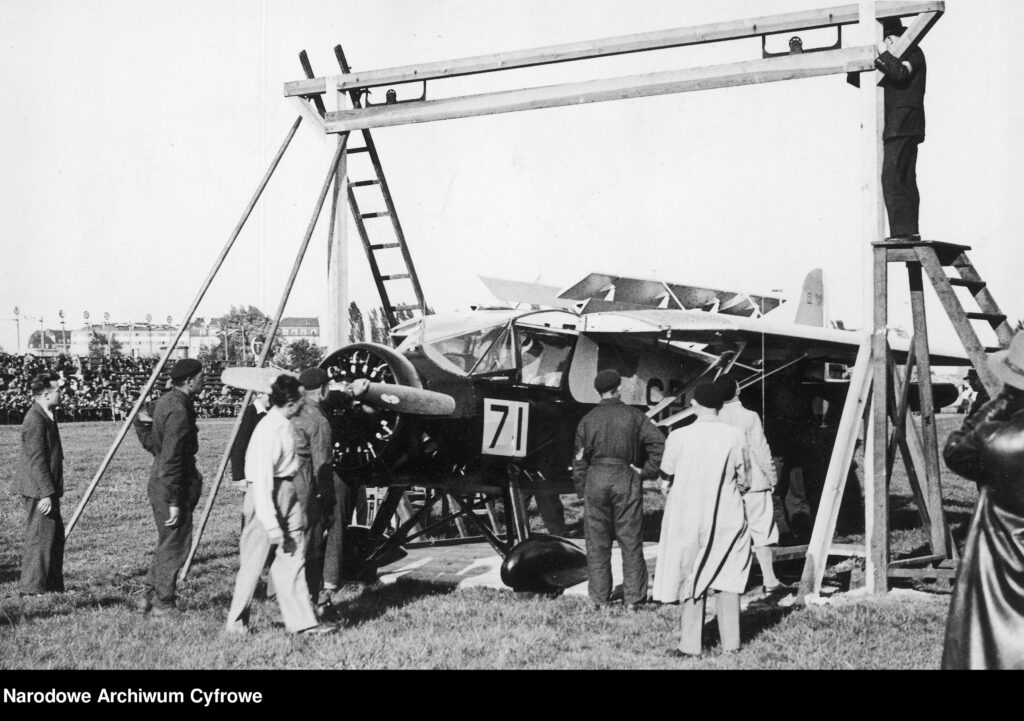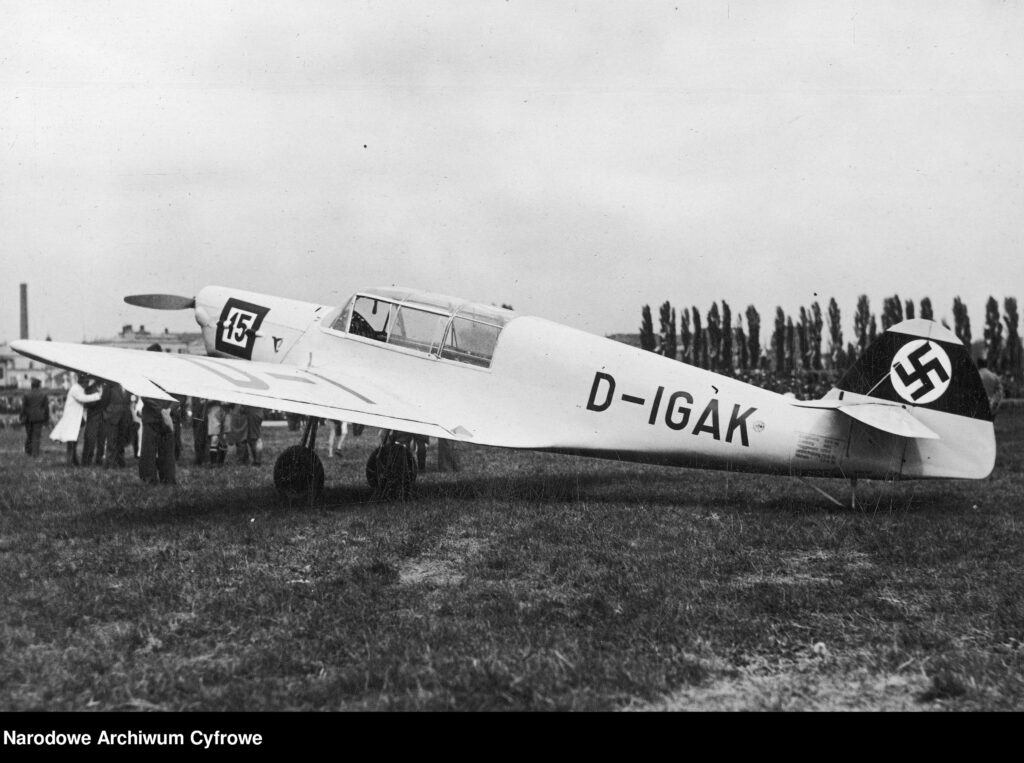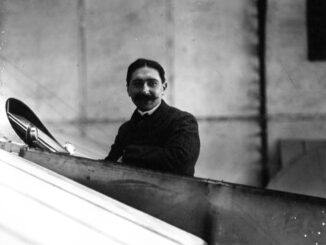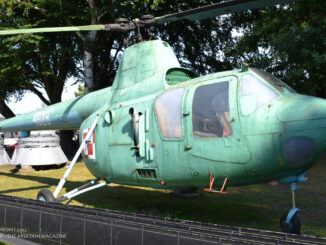 The year 1934 saw the fourth, and last edition of the Challenge series. The competition was held between 28th August and 16th September in Warsaw, Poland, because of Żwirko and Wigura victory in the previous contest.
The year 1934 saw the fourth, and last edition of the Challenge series. The competition was held between 28th August and 16th September in Warsaw, Poland, because of Żwirko and Wigura victory in the previous contest.
Regrettably, the winners of the 1932 editions could not defend their title. Two weeks after their victory, the Polish crew died in an aviation accident. A similar fate was shared by Reinhold Poss, German pilot and successful participant of all three previous editions, who was killed in an aircraft crash next year. Winnifred Spooner, the only women that officially took part in all contests of the Challenge series, died of pneumonia in January of 1933.
Rules of the Polish edition were already announced one year in advance. Although, at first sight, they looked similar to those from the previous competitions – including technical evaluation, speed trials and a rally over Europe – a lot of details changed. There was even more focusing on aircraft performance, quality and comfort, comparing to previous editions, as well as high requirements for the crews´ skills.
After six years from the first competition, Challenge International de Tourisme was no more just an interesting review of popular European tourist aircraft, accompanied by captivating presentation of piloting skills. Now, majority of the aeroplanes participating in the contest was completely new designs, made purposedly to compete, and win, the Challenge. Although they still, formally, had to meet the requirements for tourist aircraft. Many of them never went into serial production, being manufactured only in short series of few examples. For instance, only seven Heinkel He 64 aeroplanes were built and only three examples of each Praga BH-111, PZL.19 and RWD-6 were produced.
As the world was changed, the Challenge followed. The competition became a forum on which countries aspiring to be the leading aviation powers could present their latest designs and prove their air superiority. Among them there was Poland and Czechoslovakia, two countries that regained their independence after the Great War and now attempted to be regional leaders. Germany, or more precisely, the German Reich was quickly transforming into more than just European power, at the same time re-establishing its air force. And last but not least, there was Italy, another European country that aspired to be among the leaders but slowly being out shadowed by Germany.

With every consecutive edition, participating in the Challenge became more and more expensive and having increasingly connected with political background. It was then hardly surprising that many countries withdrawn from the competition, being either not able to create a new aircraft for the contest or not interested in participating in a kind of political point-scoring.
Therefore, the number of crews and national teams participating in the 1934 edition was even smaller than two years earlier. In fact, only four countries entered with their own representations – the aforementioned Poland, Czechoslovakia, Germany and Italy. In addition, there was also a British and Austrian crew participating in the Challenge, but both were a part of the Polish team, not representing their countries officially.
Moreover, the French team was expected to participate in the 1934 Challenge, but their Caudron C.500 was still under development at that time. Therefore, France finally resigned from the competition.
Germany entered competition with three types of cantilever, low-wing monoplanes: Messerschmitt Bf 108, Fieseler Fi 97 and Klemm Kl 36. Italy participated with another aircraft of similar construction, Pallavicino PS-1, and a braced low-wing monoplanes Breda Ba.39 and Ba.42. The latter design was also represented by Czechoslovak aeroplane, Aero A.200. Poland joined the Challenge with two types of aircraft – the first of them, PZL.26, was just another cantilever low-wing monoplane, but the second, designated RWD-9, was a high-wing, braced monoplane. In addition, one RWD-9 was also used by a Czechoslovak crew. For the first time in history of the Challenge, two participating aircraft – the Bf 108 and the PS-1 – were equipped with a retractable landing gear.
The only aircraft not developed especially for the purpose of participating in the Challenge was de Havilland DH.80 Puss Moth of the British crew Walther MacPherson (pilot) and Ms. Slade (passenger). Although even that aircraft was modified for the competition.
The opening ceremony, held on 28th August at Pole Mokotowskie (English: Mokotów Field) airfield in Warsaw, was marked by two events. The first one was late arrival of the Italian team that came in the middle of the ceremony. And then there was an aerobatic display of Polish PZL P.7a fighter that ended with a crash. Fortunately, the pilot survived with just minor injuries.

The fourth edition of the Challenge series began with technical evaluation of participating aircraft. It took one week to complete that part of the competition and it included the already well-known trials of overall comfort of the cabin, view from the cockpit, possibility to fold wings, instrument panel equipment and overall weight of the aeroplane. Additional points were scored for use of metal parts in construction of the aircraft. After that initial stage of the contest, the Bf 108 was the leader, followed by the PS-1 and the Fi 97.
The technical evaluation was followed by short take-off trial. It was won by Czechoslovak pilot Vojtěch Žáček, flying the A.200. Right behind him there was Jerzy Bajan in the RWD-9 and Ján Ambruš in another A.200. Although the German crews flying the Bf 108 were not successful in that competition, they still had enough points to keep the leading positions in the overall ranking.
The short landing contest was won by crews flying the Fi 97 (the first and third place) and the PZL.26 (the second and fourth place). It was followed with a fuel consumption trial that was concluded with decisive victory of the Bf 108, as the German crews taken the first three places.
On 6th September, the minimal speed trial was completed. It was exactly the contest that proved how aircraft performance evaluated from one edition of the Challenge to another. In our previous article, the situation from 1932 was mentioned, when minimum speed of 63 kph was not expected to be broken. And three winning crews – all flying even slower than the abovementioned limit – received the same scoring as the organizers were not prepared for such achievement.
In 1934, most crews were able to fly slower than 60 kph, but the top six pilots had pushed the limit even further. Jerzy Bajan, flying the RWD-9, was the winner of the low-speed trial, with an incredible speed of just 54.14 kph. He was followed by Jan Anderle from Czechoslovakia, but in another RWD-9, who made it as low as 55.24 kph. Ján Ambruš and his A.200 were the third, with 55.88 kph.

Wing folding competition was the final trial of the technical part. It was a clear victory of the Polish teams and the RWD-9 that took all the first seven places.
Eventually, results of the technical trials proved quality of the Polish aircraft. Jerzy Bajan was now the leader of the overall classification, followed by Tadeusz Karpiński and Stanisław Płonczyński (all flying the RWD-9). The best German pilot was Hans Seidemann (Fi 97), who was placed the fourth. What´s more, only three types of aircraft made it to the top ten results – the RWD-9, the Fi 97 and the A.200. The Messerschmitt Bf 108, although looking much modern than its competitors, this time was not able to score for Germany.
The 1934 rally over Europe was significantly longer than before, covering a route of more than 9,500 km long and including even Casablanca, Tanger and Algiers in northern Africa. During that edition of the Challenge, cruise speed below 130 kph, as well as being three nights late to the flight schedule, resulted in disqualification.
That race was expected to be the proper competition for the fast Bf 108 aeroplanes. Indeed, the crews flying the Messerschmitt aircraft usually were in the lead and were reported to be the fastest aeroplanes during the rally. Nevertheless, not the top speed but the regularity of the flight was awarded in that competition. What´s more, the Bf 108 crews were haunted by bad weather conditions that forced the crews to perform unexpected landings and caused delays on their way.
Eventually, the race was won by pilots that were not the fastest but by those who managed to maintain a good average cruise speed. The first was Georg Pasewaldt from Germany, flying the Fi 97, with average speed of 215.33 kph. He was followed by Ignacy Giedgowd in the PZL-26 (213.33 kph) and Ján Ambruš in the A.200 (211.12 kph). The first Bf 108, flown by Theo Osterkamp, was placed fifth with average speed of 208.74 kph. Nevertheless, it was the only Bf 108 among the top ten results.
After the rally, Jerzy Bajan with 1855 points was still the leader of the overall ranking. Stanisław Płonczyński was second with 1821 points and Hans Seidemann was placed third with 1813 points.
The maximum speed trial was the final stage of Challenge International de Tourisme 1934. With no surprise, this competition was won by the German crews and their Bf 108 that took the first three places. The Messerschmitt aircraft achieved the top speed of 291, 287 and 283 kph, respectively. However, they were closely followed by the Polish crews and their RWD-9 aeroplanes that were placed from fourth to eight. Although the Bf 108 was the best aircraft of the last trial, the German crews had still not enough points to overrun the Polish teams.

The winners of the fourth Challenge were Jerzy Bajan and his on-board mechanic, Gustaw Pokrzywka, who scored a total of 1896 points. The second place was taken by Stanisław Płonczyński with 1866 points. The best German pilot, Hans Seidemann, was third, scoring 1846 points.
The fourth place was taken by Ján Ambruš (1822 points), Theo Osterkamp was the best pilot flying the Bf 108 (5th place, 1810 points), followed by Werner Junck (6th place, 1806 points). The best Italian, Armando François in the PS-1, took the 18th place with 1561 points.
Only nineteen crews managed to complete the exhausting Challenge competition of 1934. Among those who had to resign, due to technical issues with their aircraft, was German pilot Fritz Morzik – the winner of 1929 and 1930 editions.
The next edition of Challenge International de Tourisme was scheduled for 1936. And once again, because of Jerzy Bajan´s victory, the competition was going to be organized in Poland.
Nevertheless, in 1935 representatives of the Polish Aeroclub had officially announced the Poland´s withdrawal from the Challenge series. As a direct consequence, Poland will not host the next competition. Therefore, the FAI enquired other participating countries but none of them was interested in organizing the 1936 Challenge.
Regrettably, the contest evaluated in the wrong way, being more and more demanding, both financially and technically. In addition, political situation in Europe changed and the world was again in the face of upcoming war. In the light of this, the lack of interest in organizing the tourist aircraft competition was quite understandable.
The 1934 edition concluded the Challenge series. Nevertheless, the competition has a special place in aviation history. During each edition, the competitions were observed by thousands of spectators and reported in European media. Also, the aviation development was significantly marked by the Challenge, being a trigger to create new designs and having an impact on both technological progress and aircraft performance.

Cover photo: Stanisław Płonczyński (RWD-9) during short take-off trial (photo: Narodowe Archiwum Cyfrowe, 3/1/0/5/1250/76, public domain)



